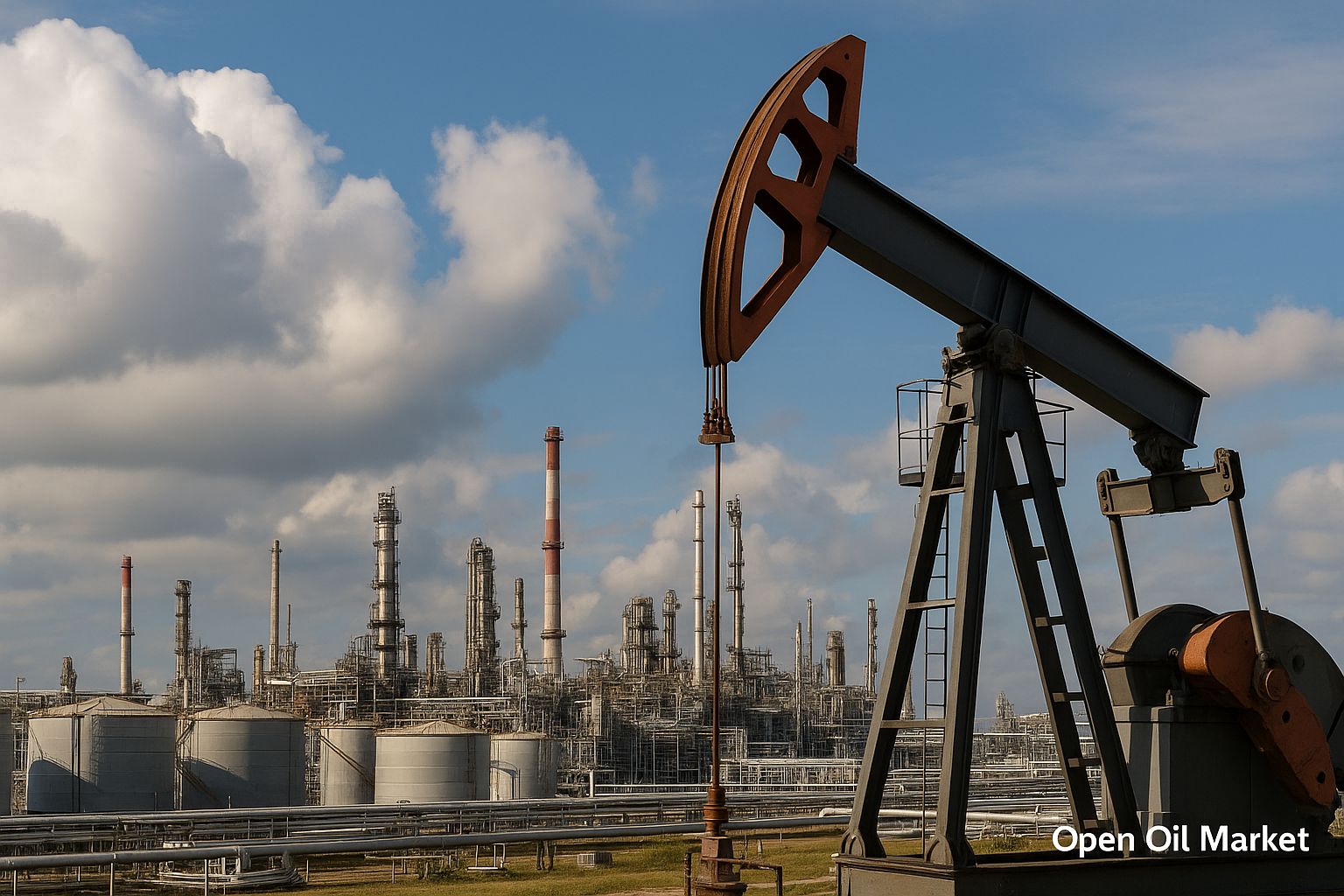
Current News in the Oil, Gas, and Energy Sector as of Friday, November 21, 2025: Oil and Gas Dynamics, European and Asian Energy, Sanctions, Renewable Energy, Coal, and Refining. Analysis for Investors and Energy Sector Companies.
Friday, November 21, 2025, greets participants in the global energy market with a mixed environment. Oil prices remain in a moderate range: Brent quotes hover around $63-64 per barrel, reflecting a combination of oversupply and cautious demand. In the European gas market, the heating season starts amidst relatively high, though not record-breaking, storage levels, while Asian consumers keep a close eye on LNG prices. The situation is complicated by sanctions: the implementation of new restrictions against Russian oil and gas companies is altering export routes for oil and petroleum products. Meanwhile, the world continues to experience a rapid energy transition—investments in renewable energy sources (RES) and electricity are reaching new highs, even as oil, gas, and coal remain the foundation of the energy market.
Global Environment: Soft Demand and Oversupply in the Oil Market
In 2025, the global energy landscape is characterized by simultaneously steady but not explosive demand and increasing supply. For investors, the key question remains the balance between oil and gas amidst high interest rates and a slowing global economy.
- Oil. Following notable volatility in the autumn, Brent and WTI quotes have consolidated near $60-65 per barrel. The market is factoring in a scenario of raw material oversupply due to increased production from OPEC+ countries and a rise in supply from the US, Brazil, and other producers.
- Gas. The European gas market has entered the heating season with relatively comfortable storage levels, but below past record levels. This creates room for price volatility during prolonged cold spells. In Asia, LNG prices are kept in check by moderate demand and the development of alternative electricity sources.
- Macroeconomics. High key rates in the US and Europe, along with slowing growth in China, are putting pressure on industrial demand for energy resources. At the same time, the transport and petroleum products sector supports a baseline consumption level.
Oil Market: Sanctions, Discounts, and New Supply Trajectories
As of November 21, 2025, the oil market's attention is centered on sanctions policy and its impact on Russian companies' exports. Amid new restrictions and potential revisions to price caps, Russia is compelled to offer additional discounts on its oil to maintain supply volumes to Asia, the Middle East, and Africa. This intensifies segmentation in the global oil market and establishes multiple price levels for different grades of crude.
- Production and Quotas. OPEC+ countries have not yet announced any significant production cuts, limiting themselves to flexible rhetoric. At current price levels, most producers maintain profitability but are concerned about further market saturation.
- Price Structure. Front-month Brent futures are trading at a discount to distant contracts, reflecting expectations of an oversupply of oil in the coming months. This creates additional risks for long-term projects while supporting consumers.
- Investment Decisions. Oil majors in North America, the Middle East, and Atlantic waters will continue to develop only the most cost-competitive projects, cautiously approaching capital expenditures amid increasing pressure from climate policy.
Gas Market: Europe, Asia, and the Role of LNG in Energy
Gas remains a key fuel during the transitional period between classical energy and RES. In 2025, the gas energy market is influenced by three factors: storage levels, electricity demand, and geopolitical constraints.
- Europe. EU countries are entering winter with gas storage at about 75-80% of working capacity—considerably below record levels, but still relatively comfortable for the start of the season. A harsh winter scenario could lead to accelerated gas withdrawal and price increases, posing a significant risk for the industry.
- Asia. In China and other Asian economies, domestic gas production and long-term LNG contracts help reduce sensitivity to spot price spikes. However, a sharp increase in demand could reignite competition between Europe and Asia for LNG.
- LNG Market. New capacities from LNG exporters in the US, Qatar, and East Africa continue to redistribute gas flows. For investors in the energy sector, this means a rise in project value linked to global gas indexes and a need to account for both local and inter-regional price signals.
Electricity and Coal: High Loads and Climate Pressure
The electricity market in 2025 is demonstrating steady load growth amid digitalization, electrification of transport, and industry. At the same time, coal, despite climate pressures, remains an important source of generation, especially in developing countries.
- Electricity. In Europe and the US, utility companies are preparing for potential winter consumption peaks by increasing reserve capacities and modernizing infrastructure. With the growing share of RES, ensuring the stability of the energy systems becomes a key task.
- Coal. Global coal consumption in 2025 is shifting from growth to a plateau phase. Amid tightening climate requirements and the development of RES, mining companies are forced to optimize costs and postpone launching new projects.
- Regulation. Several countries are introducing additional carbon charges and quotas to encourage a shift from coal to gas and renewable energy sources, directly affecting the structure of generation and price dynamics in the electricity sector.
RES and the Energy Transition: Record Investments and New Challenges
Renewable energy sources (RES) are the primary beneficiaries of the global energy transition. In 2025, investments in green energy and electricity infrastructure continue to set records, outpacing investments in fossil fuels. For the energy market, this signifies increased competition between the traditional energy sector and the new "clean" energy sector.
- Investment Trend. Global investments in solar and wind generation, energy storage, and grids have approached levels comparable to total investments in oil, gas, and coal in 2025. This intensifies pressure on the margins of traditional companies and compels them to diversify their business models.
- Technologies. Scaling storage systems, developing hydrogen projects, and digital demand management platforms are becoming key growth areas. New solutions allow for better integration of RES into energy systems and reduce the role of peak gas and coal generation.
- Regional Divide. While developed economies and China concentrate the majority of investments, developing markets face capital shortages for "green" projects. This creates a niche for international financial institutions and private investors willing to take on country risks.
Petroleum Products and Refineries: Margin Stabilization and Domestic Pricing Policies
The petroleum products market at the end of 2025 shows a more stable picture compared to the beginning of the year. For refineries in Europe, Asia, Russia, and the Middle East, a key task remains flexible management of throughput and the product assortment of petroleum products produced.
- Refining Margins. Lower oil prices amid stable demand for diesel and aviation kerosene support refining margins. This encourages refineries to make full use of modernized capacities, especially in regions with developed export infrastructure.
- Domestic Markets. In many countries, including Russia, measures to protect the domestic petroleum products market—export restrictions, damping mechanisms, and price regulation—continue to be in place. This affects the strategy of refineries and the balance between export and meeting domestic demand.
- Environmental Standards. Stricter fuel quality requirements (sulfur content, emissions) stimulate additional investments in refinery modernization, hydrocracking, and depth of processing. For investors, assessing the effectiveness of capital expenditures considering potential carbon taxes is crucial.
Key Risks and Opportunities for Investors in the Energy Sector
In the upcoming months, the energy market will be influenced by several key drivers that directly impact oil, gas, electricity, and related assets.
- Sanctions Policy. The implementation of new sanctions against Russia's energy sector and potential tightening of price caps may widen spreads between oil grades and reduce the profitability of certain players, while creating arbitrage opportunities in trading.
- Winter Factor. The nature of winter in Europe and Asia will determine the trajectory of gas and electricity prices. A harsh winter could lead to another round of price increases and stress-testing gas supply and electricity systems.
- Rate of Energy Transition. The adoption of new climate commitments and increased investments in RES could accelerate the reallocation of capital from fossil fuels to green projects, heightening structural risks for companies tied to coal and older oil assets.
- Macroeconomics and Interest Rates. A prolonged period of high interest rates raises the cost of capital for capital-intensive projects in oil, gas, electricity, and RES. In these conditions, projects with low operational costs and stable cash flows will benefit.
Market Takeaway: How to Act on November 21, 2025, and Beyond
For investors and companies in the oil and gas and energy sectors, the key challenge as 2025 comes to a close is balancing short-term market conditions with long-term trends in the energy transition. Moderate prices for oil and gas, high investment in RES, sanctions pressures, and regulatory uncertainty create a complex but predictable agenda.
- In the short term, attention should be focused on sanctions dynamics, winter demand for gas and energy resources, and OPEC+ decisions on quotas.
- In the medium term, it is critical to assess the resilience of energy companies' business models to tightening climate policies and the growing share of RES in the energy balance.
- For diversified portfolios, a sensible strategy seems to combine high-quality oil and gas assets, infrastructure (pipelines, LNG terminals, grids), and growing segments of renewable energy and electricity.
Thus, Friday, November 21, 2025, captures a situation of "managed turbulence" in the oil, gas, and energy markets: fundamental indicators remain relatively stable, yet geopolitics and climate agendas demand heightened attentiveness to risks and flexibility in investment decisions.




